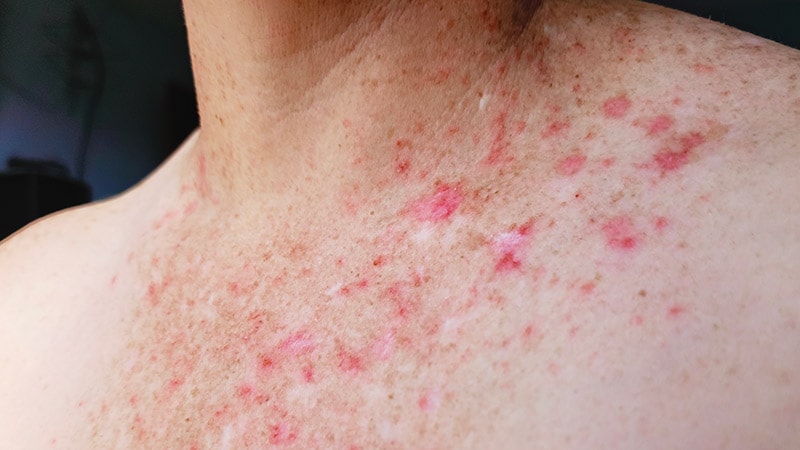Effectiveness and Accessibility of Home Phototherapy for Treating Moderate to Severe Psoriasis
แนวคิดหลัก
Home phototherapy can be an effective first-line treatment for patients with moderate to severe psoriasis, offering a safe and accessible alternative to office-based treatment.
บทคัดย่อ
The article discusses the findings of the LITE study, which compared the efficacy of home-based and office-based narrowband ultraviolet B phototherapy for the treatment of plaque and guttate psoriasis. The study found that home-based phototherapy was non-inferior to office-based treatment in achieving a Physician's Global Assessment (PGA) score of 0/1 (clear, almost clear) and a Dermatology Life Quality Index (DLQI) score of 5 or less (small, no effect on health-related quality of life).
The article highlights several factors that support the use of home phototherapy, including its lower cost compared to biologics and the limited availability of office-based phototherapy in many parts of the United States. However, the article also notes that insurance coverage for home phototherapy can be variable and that clinicians may need to advocate for its coverage with payers.
The article provides practical guidance for clinicians on optimizing access to home phototherapy for eligible patients with psoriasis. Key recommendations include:
Discussing home phototherapy as a treatment option with patients
Engaging in shared decision-making to determine if home phototherapy is appropriate
Educating themselves on the available home phototherapy units and their features
Recognizing the limitations of phototherapy and the need for maintenance treatments
Anticipating and addressing potential challenges with insurance coverage
Home Phototherapy for Psoriasis: Optimizing Access
สถิติ
"25.6% of patients in the office-based phototherapy group achieved a PGA score of 0/1 compared with 32.8% of patients in the home-based phototherapy group (P > .0001 for noninferiority, non-response imputation for missing data)."
"33.6% of patients in the office-based phototherapy group achieved a DLQI score of 5 or less compared with 52.4% of patients in the home-based phototherapy group (P > .0001 for noninferiority, non-response imputation for missing data)."
คำพูด
"For people who are not interested in systemic medications or who have contraindications to systemic medications, phototherapy would be ideal."
"When a patient comes in, I'll discuss what their treatment options are and [we] will decide upon a course of action based on their unique needs and preferences [and] if it's medically appropriate, meaning they have the type of psoriasis likely to respond to phototherapy."
ข้อมูลเชิงลึกที่สำคัญจาก
by Doug Brunk ที่ www.medscape.com 05-22-2024
https://www.medscape.com/viewarticle/home-phototherapy-psoriasis-encouraging-new-data-optimizing-2024a10009nt
สอบถามเพิ่มเติม
What are the potential long-term benefits and drawbacks of home phototherapy compared to office-based treatment for patients with psoriasis?
Home phototherapy offers several long-term benefits for patients with psoriasis compared to office-based treatment. Firstly, it provides convenience and flexibility, allowing patients to undergo treatment at home without the need for frequent visits to a healthcare facility. This can lead to improved adherence to treatment regimens, which is crucial for long-term management of psoriasis. Additionally, home phototherapy can result in cost savings for patients, as it eliminates the need for travel expenses and time off work for clinic visits.
However, there are also potential drawbacks to consider with home phototherapy. Patients may face challenges in operating the phototherapy equipment correctly, which could impact treatment efficacy and safety. Monitoring for adverse effects and ensuring proper dosing may be more challenging in a home setting compared to a clinical setting where healthcare professionals can closely supervise treatment. Moreover, the initial cost of purchasing a home phototherapy unit can be a barrier for some patients, although it may be offset by long-term savings.
What factors, beyond efficacy and cost, should be considered when determining the suitability of home phototherapy for individual patients with psoriasis?
When evaluating the suitability of home phototherapy for individual patients with psoriasis, several factors beyond efficacy and cost should be taken into account. Patient characteristics such as age, physical abilities, and willingness to comply with treatment instructions are crucial considerations. Patients must be capable of operating the phototherapy equipment safely and reliably, as well as have the necessary space in their home for the unit.
Additionally, the location and extent of psoriatic lesions play a role in determining the appropriateness of home phototherapy. Patients with psoriasis primarily affecting areas that are difficult to treat with phototherapy, such as the fingernails or genitals, may not be ideal candidates for home treatment. It is essential to assess the patient's overall health status, comorbidities, and treatment preferences to ensure that home phototherapy is a suitable option that aligns with their individual needs and lifestyle.
How can the integration of home phototherapy into the broader management of psoriasis, including the use of topical agents and other therapies, be optimized to achieve the best outcomes for patients?
To optimize the integration of home phototherapy into the broader management of psoriasis and achieve the best outcomes for patients, a comprehensive and individualized treatment approach is essential. Shared decision-making between healthcare providers and patients is key to determining the most suitable treatment plan that aligns with the patient's preferences and needs. This includes considering the use of topical agents in conjunction with phototherapy to target specific areas of psoriasis that may require additional treatment.
Regular follow-up appointments are crucial to monitor treatment progress, assess response to therapy, and make any necessary adjustments to the treatment plan. Patients should be educated on the importance of adherence to treatment regimens, proper use of phototherapy equipment, and self-monitoring for any adverse effects. Healthcare providers should also collaborate with insurance companies to advocate for coverage of home phototherapy and streamline the approval process to ensure timely access to treatment for eligible patients. By taking a holistic approach to psoriasis management and optimizing the integration of home phototherapy with other therapies, healthcare providers can help patients achieve optimal outcomes in the long term.
0
